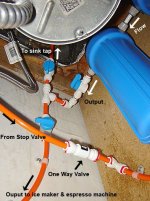Randy G.
New member
Yesterday morning I completed my water filter system. I will be getting a Vibiemme Domobar Double in the next few weeks and since it can be plumbed, and I am sick of filling and refilling the reservoir and emptying the drip tray, I prepared for its arrival. My water here is from a private ell and has a lot of calcium carbonate so we have been using reverse osmosis water from the blue machines mixed with Brita filtered water. Lugging four gallon bottles of water is a pain, and we aren't getting any younger. The planned arrival of the plumbed machine was the motivation I needed.
The system consists of two, 10" filters, one with an ion exchange softener and the other a carbon filter.

Above is the main part of the plumbing job. The valve to the espresso maker is closed in this pic because I wasn't finished with that portion of the system when I took the picture. That portion was finished yesterday. I can say that working under the house with JG plumbing makes it a lot easier.
You can see that I have placed a number of valves into the system. These enable me to turn off teh water to any single device in the system without disabling anything else. There are three more valves not shown - One on the input side of the filters that turn off everything, one at the ice maker and one at where the espresso machine will be.
Even though the plumbed machine is not here, I put the valve for that at the end of the line and can use that like one would use a nozzle at the end of a hose to fill the reservoir of the existing machine.
The entire planning and installation is detailed on my website.
The system consists of two, 10" filters, one with an ion exchange softener and the other a carbon filter.

Above is the main part of the plumbing job. The valve to the espresso maker is closed in this pic because I wasn't finished with that portion of the system when I took the picture. That portion was finished yesterday. I can say that working under the house with JG plumbing makes it a lot easier.
You can see that I have placed a number of valves into the system. These enable me to turn off teh water to any single device in the system without disabling anything else. There are three more valves not shown - One on the input side of the filters that turn off everything, one at the ice maker and one at where the espresso machine will be.
Even though the plumbed machine is not here, I put the valve for that at the end of the line and can use that like one would use a nozzle at the end of a hose to fill the reservoir of the existing machine.
The entire planning and installation is detailed on my website.
